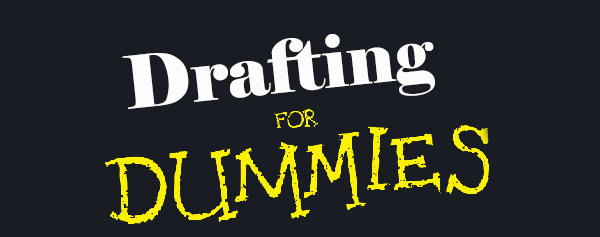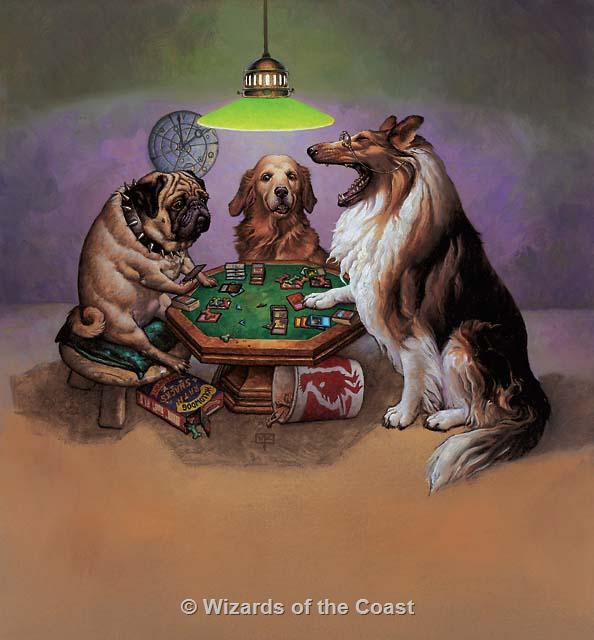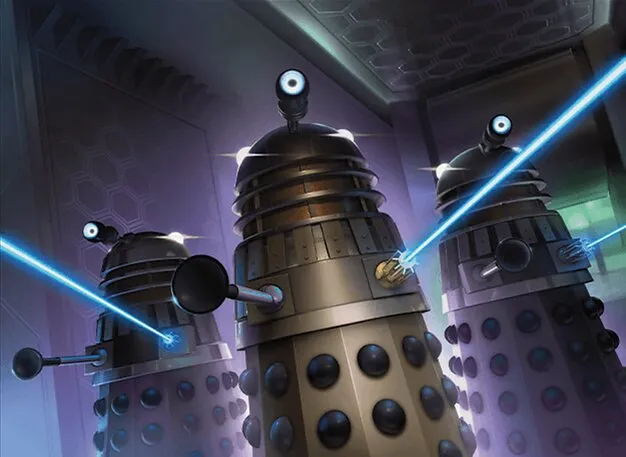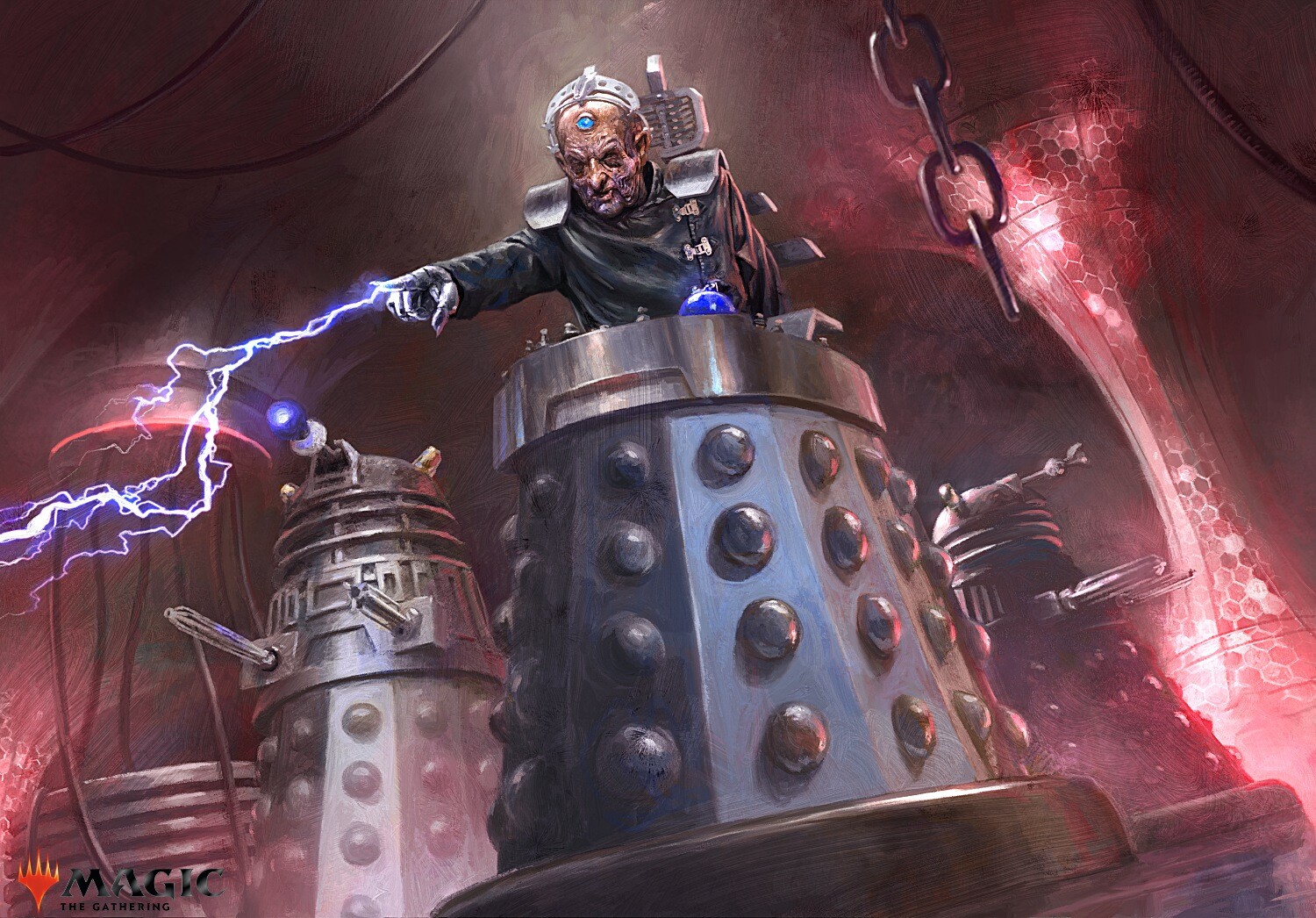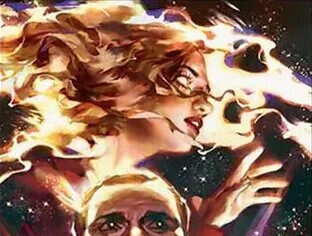Drafting Magic the Gathering
By: Daniel Clayton -The Will of the Floral SpuzzemWith Conspiracy just recently released, and the magic community moving more and more quickly to accept drafting as its own stand-alone format, it is time to review the fundamentals of drafting magic the gathering. Drafting is a unique format where cards that are unplayable in other formats find new homes in decks that you normally wouldn’t see. It is uniquely positioned as many players first steps into any set. Allowing players a chance to dream up ideas for decks they can use in later tournaments, examine interactions between various cards and refine strategies that may or may not be successful. Up until recently I drafted only a few times with no clue how to do it. This is not a definitive guide on how to draft; if you have found better strategies than mine to use, stick to them. I will only try to show you some of my most basic strategies that I use to draft and offer you my experiences in using them.
Pre-game
This is really more of an optional step, many players love to discover the cards as they draft, if you’re someone that wants the thrill of trying to build a deck as you learn the cards in the set then skip this step; if you’re like me, however you will want to learn the set well before you go into a draft. The first step in doing this is to find a site you like that posts visual spoilers as they become available, for me this is Mythic Spoiler, a site I found out about when Modern Masters came out, coincidentally this was also the set that propelled me into my love for drafting. [Ed.Note: we also preview all the cards right here on The Bag of Loot !!!] Learning what cards are in a set involves not memorizing every card in a set, but it does involve becoming familiar with a set well before a set comes out. There are a whole bunch of reasons to do this, including knowing what colors are strong and what colors are extremely weak in a set; you do this to keep you from getting stuck with a color you can’t build a deck off of because of one card in a set. This is a danger in any set if you don’t know it well enough, because you see one card that you need to build a deck around and then you try too hard to do just that and you wind up passing up a halfway decent deck for trying to build around 1 “bomb” card. Another reason to learn a set is one we will get to later, which is it gives you a chance to know what you’re looking for when you go to a draft. Additionally, on top of everything else is something which we will also get into a little bit later; that is the ability to watch out for value cards. Finally, you can start to build new decks you’re planning to use in the next tournament season by knowing all of the new cards.
Order of Selection
I read an article about drafting a while ago and it addressed this order in more detail, it was on the Wizards website and they talked about top-down drafting and booster pack drafting. You can search either on Google and get linked up to the site. I will briefly go over the order or the order that I believe you should pick in in this article. Above everything else, drafting is a monetary technique; you are attempting to get more than your money’s worth either through luck or through your own skill. As it is such a monetary technique, your first pick should always be money picks. This relates back to the previous paragraph, before everything else, you should be watching out for money picks. This involves again a little bit of pre-gaming, but it is definitely worth the time. This step involves finding a card selling site that pays out consistently; for me this site is Starcitygames.com and while this site is essentially the Gamestop of the Magic universe, there’s a reason that they are still the largest Magic dealer in the world. [Ed.Note: you can also sell to Three Kings Loot with a great bonus for Store Credit !!!] That is to say that they are essentially too big to fail, they sell more cards, have more tournaments and are more well-known than any other single retailer for the game, and as such their buy list is equally impressive both in quality of card prices and breadth of card’s they are willing to buy. (As a side note, if you are trying to build a deck, it is sometimes worth it to trade these cards for store credit versus selling them straight out as they throw in extra value when you do) Now there’s also much to consider with how valuable a card is, while it is true that you should pick value cards first but the rule for picking them first is the card that you take has to be a minimum of close to equal value to the tournament you are participating in. It doesn’t make a lot of sense to trade a twenty-five dollar tournament for a 15 dollar card, does it? The next type of card you’ll pick is cards that you’re looking for. Again this really does relate back to money, but in a different way and of course it can also be looked over if the card isn’t worth it. Let’s just think about it like this, if you’ve already decided you’re going to build a deck and you see a three dollar card you need to pick up for said deck in your pack and you take it, well now you don’t need to invest the three dollars in the card you were going to buy, because you already have it. Additionally, if you’ve got a pack of cards that you don’t really care about it doesn’t really hit any of the criteria, but it’s one you need versus one that’s moderately better or more expensive, well you know the old expression. (A penny saved is a penny earned) The next card you pick is cards that build into your strategy, this really only applies if you’ve already built a strategy. This should be self-explanatory if you see a card that plays into the strategy that you’re building, you should go for it. After that comes the cards you have to pick for each color. If you don’t have a strategy yet, then you need to start coming up with one and this typically devolves into picking good cards you see for each color and funneling yourself into one or two colors. Up next comes hate drafting, if you don’t see anything that really helps you in a pack, then maybe it’s time to take out cards that you just don’t want to deal with, this can be the difference between winning and losing a tournament right here. If you see a card you just can’t deal with get it out of the way so that you don’t have to and who knows maybe your colors will change later on and it may be one of the most influential cards in your entire deck. There are two dangers in doing this, however, the first is you may lose your ability to send proper color signals, which we’ll get to later. The second is that it may make you enemies. Remember when you’re drafting, you’re drafting with 5 or 7 other people, and if you make enemies with them, you make enemies with them. They will hate draft you and may skip over better drafts just to get at you. Just remember hate drafting is fine, but don’t overdo it. (You still need to build a deck to win) If you don’t see any of these, maybe it’s time to fill out your deck. The giant bombs in your deck are great, making every deck except yours in a tournament weak is important, but in order to win the game, you still have to be able to get through to the end of your game and it’s filler that lets you do this. A solid 3/3 for 2 is a great filler card for example and in just one hit to the face you can get value out of your card. After this, you should take the random rare or funky card that no one’s really found a use for yet. Remember cards in this group include, Tarmogoyf, and Ravenous Demon. The one caveat I’d like to add to this is just to remember that for every Tarmogoyf there are about a million Scrambleverses, and Goblin Test Pilots; another point is that even if the card isn’t that good, it can still be a ton of fun to play with. Next up is a holographic card, if there’s nothing good and there’s nothing that helps or is fun, maybe it’s time to take the foil. Remember, even a bad foil may be worth a dollar or two to the right person and that’s money in your pocket. After that if it comes right down to it, take a card in your colors, then a value creature, than a value spell, then a creature, then just take a random card. At the end, it really comes down to trying to build value out of nothing, but it does lead us into our next two points.
Playable Cards
In draft cards that you would typically find unplayable in another format, you’ll find yourself relying on heavily in draft. For example, a 4/1 for 2 mana can be a great addition to your deck or even a Vizzerdrix, which is a vanilla 6/6 for 6 blue mana. You have to remember that the format is typically much, much slower than other formats, as players typically don’t have strategies that consistently win you games by the third or fourth turn. Real quick and because I feel like it is important, let’s talk about deck fillers real quick. Now when people draft they typically want to think about the big pulls, the amazing cards, the foil Tarmogoyf in their pack. The draft is typically won, however by the fillers; that isn’t to say that someone who is amazingly luck and gets amazing pulls won’t win, but when you get right down to it, luck is not a reliable way to win tournaments. Let’s define filler real quick, filler is anything that isn’t absolutely amazing, such as a Tarmogoyf or Vendillion Clique, it doesn’t contribute heavily to any strategy, such as a Spellstutter Sprite in a fairy deck, and it isn’t a card that you “have to pick” if you choose to be in a color. These cards are essentially the cards that you pick and they don’t say to yourself “I’m so glad I got that card.” They’re the vanilla 3/3’s for 3 or the counter spell for 5 mana that also lets you land cycle for 2. The bombs may win the game, but it’s the filler that typically gets you to that point (but sometimes they do all the work themselves even). There is even a type of deck built entirely around the concept of filler, and that is mono-red burn or goblin, and you’ll notice they’re all just solid cards that do what they’re supposed to do, and never really have the “WOW” feeling you get with a card like Force of Will or Tarmogoyf. Some great filler you don’t think about are equipment cards, such as Bonesplitter. These vanilla equipment cards that make small things big things are great, because it makes almost all of the creatures in your deck bombs.
Taking Bodies
This is a concept that took some one explaining to me, in order for me to get it. It goes kind of like this, if you have the option of choosing between a sorcery or instant and a creature with a similar but slightly worse effect, you should go with the creature every time. Don’t violate the order of card selection to do this, but there are many reasons to do this. First and foremost is the fact that creatures do so much. Think about it, if your creature has an effect, you get its effect. Additionally, it sticks around after the fact to be a body, and be used to protect you, draw fire away from you, remove threats, and potentially even bring you closer to winning the game; allowing you to get the most value out of a card. On top of power toughness and mana cost with creatures, you should also take into account static effects like evasion that the cards have as well. A 2/3 flyer can be better than a 3/4 ground pounder for the same mana cost. Effects like this can make a card an unanswerable threat to more unprepared decks; meaning that a simple effect like flying can win you an entire game, round or even tournament. It goes exactly the opposite as well, picking up a creature with flying or reach can keep you from losing a whole tournament.
Card Advantage
This is a concept you see throughout the formats in magic; it is not however as pronounced in the other formats as it is in draft. The amount of cards in your hand is a resource, just like life, mana, and number of permanents. In drafting however this quickly turns into the most valuable resource in the whole game, as opposed to it being board presence in most of the other games. This isn’t to say that just having cards in your hand will win a game for you, but it can give you the edge against any opponent. The mana cost for card advantage is almost negligible in draft; a mana cost of five for three or four draws is actually a pretty good deal in draft. The need for so many extra cards in your hand comes from the fact that many of your cards don’t do a whole lot besides sit in your hand, and wait to occupy a space on the field. In a more constructed format, you will typically sit on cards in your hand that all have situations in which you’d play them. Additionally, in a more constructed format, you will typically have a mana curve and make full use out of each card in your hand or you’ll have a consistent way to draw all the cards you want.
Deck Construction
Decks in drafts have to be a minimum of forty cards, and this section tries to explain the formulation of the decks that you should aim to build. First let’s talk basics you typically want 17 lands, somewhere between 14 and 19 creatures and anywhere between 4 and 9 other spells (Artifacts, sorceries, instants, and planeswalkers). This is really only a basic idea of the breakdown of a deck and is subject to change, but you should still try to stick close to it as it’s pretty reliable. The number of spells changes based on the strategy you’re going with; in control, you would aim for the least creatures and most spells. Additionally, there are spells and artifacts that produce creatures in addition to any other effects and you could count these to either the creature or extra spell category. The mana should be a firm count for the most part unless for something you need less mana than your typical deck, such as red burn. In reference to mana, let’s talk more about how much you should add of each type assuming you’re running more than 1 color. If you’re running 2 colors and it’s a pretty easy split, you should run 8 of the color you have less of or has cheaper spell in that order and vice versa. If you have about 3 quarters the amount of one as the other, you should run 7 of the lesser and 10 of the more; going any less than that puts you at risk of not getting the mana when you need it.
Sending Good Color Signals
When you draft you will receive 3 packs of random cards of 5 different colors (6 if you count colorless), and you are expected to make a deck of forty cards of 1 or 2 colors out of this (There are a few 5 color decks out there and even a few really good ones, but most of them do not last very long). While many players do this, they do not know the name and in many cases don’t even realize that they are doing it. Sending Good Color Signals is a process that involves two parts strategy, three parts common sense and one part luck. Color signals are basically a language in draft that signifies to every player on the board that a player is playing a color. (This is both why this is important and why it can be a weakness) This is important, because it lets everyone at the table know that someone is drafting this color, and if you want more good cards, you should choose a different color, because I am going to try to take all of them in this color. This is also dangerous, because it tells everyone at the table that someone has quite a few chips invested in a particular color and if you want to get them in trouble taking a good card or two of that color might be a nail in their coffin. By and large sending good color signals is an effective and beneficial tool, remember while it can be used against you, most of the people who are participating in the tournament also want to win, and they can’t do this very well if they devote all their time to taking someone else down. There are actually two parts to sending good color signals, they are sending good color signals and reading good color signals. Sending good color signals means selecting cards of 1 or 2 colors consistently to build a deck. Reading color signals well means to look at the pack and knowing what the most selected colors are going to be, it typically is going to take a little while for you to catch on to this as it takes people a little while to decide on a color. For the sake of sending good color signals and protecting your color you have to be careful about hate drafting too much.
The Element of Surprise
There was an article written on the wizards website a while ago about the difference between deceitful and technical play. Technical play is when you make moves while mitigating the amount of mistakes you make in your play. It is for example, knowing when to go all in with all your creatures, or when to hold back two or three to protect your life. It is a skill which is built simply by playing more frequently, paying attention to every move you make, and amending your mistakes in technical play. This may involve going back and rereading the rules a few more times or taking each step as it’s supposed to be taken. (Drawing after you take your untap and upkeep steps) The article went on to talk about how even though many of us may never be as good as the pros at Technical Play, (This isn’t to say that they don’t make any mistakes, it’s just to say that as it is their job, many of us will not play as many hours in as many competitive events as them) one area we may be able to keep up with them in is Deceitful play. Let’s just talk about something really quick, the word deceitful; it’s a word with really negative connotations, isn’t it? Let me just clarify, when I say deceitful I’m not talking about cheating, neither myself nor any respectable player/game store puts up with cheating in the least. What I am talking about however is manipulating the board state to make your opponent not make a move or vise versa. You accomplish this by making your opponent think you have cards in your hand or a board state that makes taking a technically correct move wrong. For example, when your opponent is too afraid to play their best card, because they believe you may have a counter on board. While this is a pretty good example, I’d like to give one more. Let’s say that it’s your opponent’s turn; his declare attackers step. On board you have two forests open and a 1/1, two cards in hand (let’s say forests for arguments sake). Your opponent has a 3/3 and no cards in hand. As soon as the step starts, you say, “I float two mana and…” You reach for one of the forests in your hand and stop yourself. “You haven’t declared yet?” You ask and pull your hand away from the cards in your hand. In this situation, the idea is that you are making your opponent believe that you have the monstrous growth. As such, even though this wouldn’t happen in the real world, you opponent makes the bad technical choice and doesn’t attack. I won’t negotiate the morality of this maneuver, but it is entirely legal in a tournament. This whole idea of deceptive play comes into the game even more than this quick wheeling; it can even be applied to specific cards. I would like to talk about two cards from the Theros block as examples for this. The first is Defend the Hearth, a brilliant little card that cancels out combat damage dealt to players until the end of turn. This can be the difference in games where players of the set typically lay out gigantic behemoths and swing out with their entire boards, and the player that wins would have lost in one more turn. The next card I want to talk about is portent of betrayal. Basically, the idea behind this card is take the blocker you can’t deal with or your opponent’s largest creature and make it work against them for a turn. This is another one that works well in this format because players in this format tend to get gigantic creatures, and swing out on their turns. There are tons of other great draft cards that I don’t want to get into too much detail about here, such as Shrieking Affliction (Make them forget about it by not doing anything with it for a long time and they’ll take 3 damage pretty consistently in the long run) or take possession (Same idea as portent of betrayal, but with anything). Long story short, you really can never tell what will be a great deceptive card and what won’t, that’s why it doesn’t hurt to pack a few into your deck and try them out, and remember, your demeanor when trying to pull something like this off can be just as important as the card and strategy you’re trying to pull off.
The Keys to Victory
When it comes right down to it, there are no definitive keys to victory in draft. You can meet a million different people with a million different so-called “Keys to Victory” in draft and the problem is that a majority of them will be right situationally. If you were to ask me what the keys to victory in draft were however, I would probably say flexibility and truly the flexibility of draft is one of the things that makes it so much fun and so difficult for so many people to become good at draft. Let’s just compare constructed to draft for a second. In constructed you build a deck and you know your deck fairly well, additionally, you can pretty much autopilot most of your decisions, as the deck pool can be terribly limited, especially in the eternal formats. There is no doubt a reason for this, your draws being fairly consistent and the decks that are their have stood the test of time and are undoubtedly some of the best decks in the format. Limited on the other hand, is a format where no two tournaments are the same and even drafting the same set multiple times, you will typically see a different deck every single time you play a game (even against the same player). It’s a format that makes you think on your feet in a lot of situations, responding to a board state that you may never have seen or even considered before. This is true not only of when you are playing but the same also rings true when you are drafting. To enunciate this point, allow me to share another story with you. As I said before, I really got into drafting around the time that Modern Masters came out. As was mentioned in the beginning of the article I really did my homework on the set, memorizing basically every card in the set, as well as the prices of anything above three dollars on Starcitygames. It was also around this time that I decided I wanted to build affinity in Modern. This meant that at the draft, I would draft value cards and cards that would go well in the new deck I was building as well as I could, mostly artifacts. On top of all this most of the artifacts were a throwback to Mirrodin, which is where I started the game. I went with this strategy most of the night, pulling decks that were okay, but never really came together as I wanted them to and as such landed me a pretty low-ranking in most of them. Finally, in the last draft of the night, I was in trouble it was around the second round of the second pack and I really hadn’t picked up any good artifacts; needless to say I was in trouble. I re-evaluated at this point and looked through the cards I had taken. A lot of filler cards I hadn’t really found a use for, but were pretty good filler nonetheless. Then I noticed something I hadn’t all night, (because I wasn’t reading my color signals very well) blue was open. I didn’t have everything I needed, but 3 Spellstutter Sprites, a handful of counters and some Dreamspoiler Witches, and I knew what I should build, Blue/Black Faeries. I switched my strategy completely at that point and the next pack rewarded me with a Tombstalker. That deck with only one rare and I had switched to in the middle of the second round wound up going on to take 5 damage the rest of the night and coming in first throughout the whole tournament. What I’m trying to say is, keep to the rules I established here and you should be ready to play in whatever format of draft you decide to participate in; know the format, but don’t be afraid to be flexible. The one caveat I’d like to add to this point is one that I’ve mentioned all along, remember no matter what deck you pick, what strategy you go with, you still need to build a 40-card deck out of it that works. I have one final point to make and it’s this…
Magic is a game, treat it like one. When you go to tournaments all of the great plays won’t really matter if you don’t have fun. So get out there win some games, but most importantly have fun at the tournament.
by The Will of the Floral Spuzzem Daniel Clayton Twitter: @DC4VP
